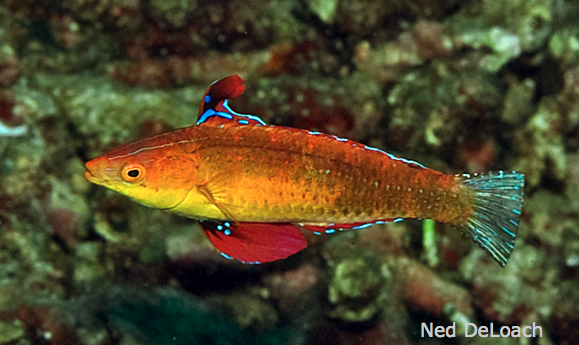
Cirrhilabrus humanni is one of 25 new species to be documented from the East Indies, and will be featured in Allen and Erdmann’s new book. In May 2010, Ned and Anna De Loach documented a previously unknown fairy wrasse in the island of Alor, Indonesia. The characteristic appearance of this fish has led its discoverers to coin the nick-name “Stubby-fin Fairy Wrasse”. In February last year, we shared a photo of the presumably new fairy wrasse photographed by Ned DeLoach. The fish has been described recently by Dr. Gerald Allen and is now a new valid member of the Cirrhilabrus genus – Cirrhilabrus humanni.
[youtube width=”680″ height=”400″]http://www.youtube.com/watch?v=KIh3xwaQLoc[/youtube]
The video above by BlennyWatcher is some of the first ever footages of Cirrhilabrus humanni in the wild and features a spectacular male in nuptial display. The excellent video showcases the typical spawning ritual of any Cirrhilabrus and Paracheilinus in great detail from start to end. Courtship is initiated when males display towards gravid females. The enhancement of color, often accompanied by metallic sheens, and rapid swimming movement is done as an advertisement. The spawning accent is short but eventful and is also well documented in the video. What’s beautiful about this footage is that we get to see numerous male Paracheilinus flavianalis mingling with females of their species as well.
Fairy and flasher wrasses often mix around in the same reef and spawn at the same time. The flasher wrasses are especially messy during their spawning rituals and very often, hybrids occur between similar species. One look at Cirrhilabrus humanni and the first thing that comes to mind would be both the dorsal and ventral fins. The elongated dorsal fin and large ventral fins show a strong relation with members of the Cirrhilabrus “rubriventralis” complex, in which C. humanni is most likely associated with.

The “rubriventralis” complex of fairy wrasses contains about seven to eight members – Cirrhilabrus rubriventralis, C. morrisoni, C. joanallenae, C. naokoae, and a few species yet to be described including the ambiguous ones coming from Kenya and some parts of Indonesia. Cirrhilabrus humanni not only shares physical traits with the members of this complex, but the style of nuptial display is also similar. Cirrhilabrus humanni displays in the exact same way as Cirrhilabrus naokoae, in which the tail takes on an incredible metallic sheen and the dorsal fin is raised like a little shark.
[via BlennyWatcher]



